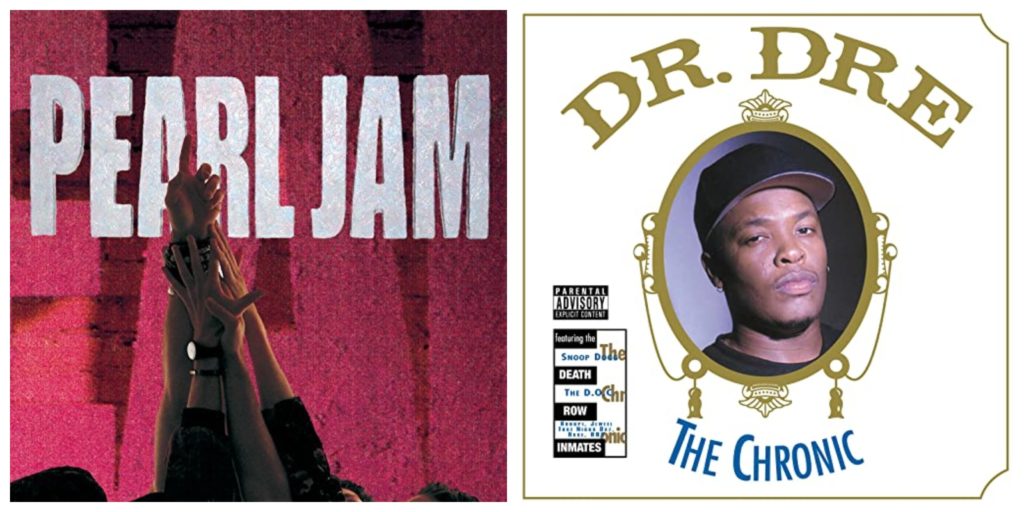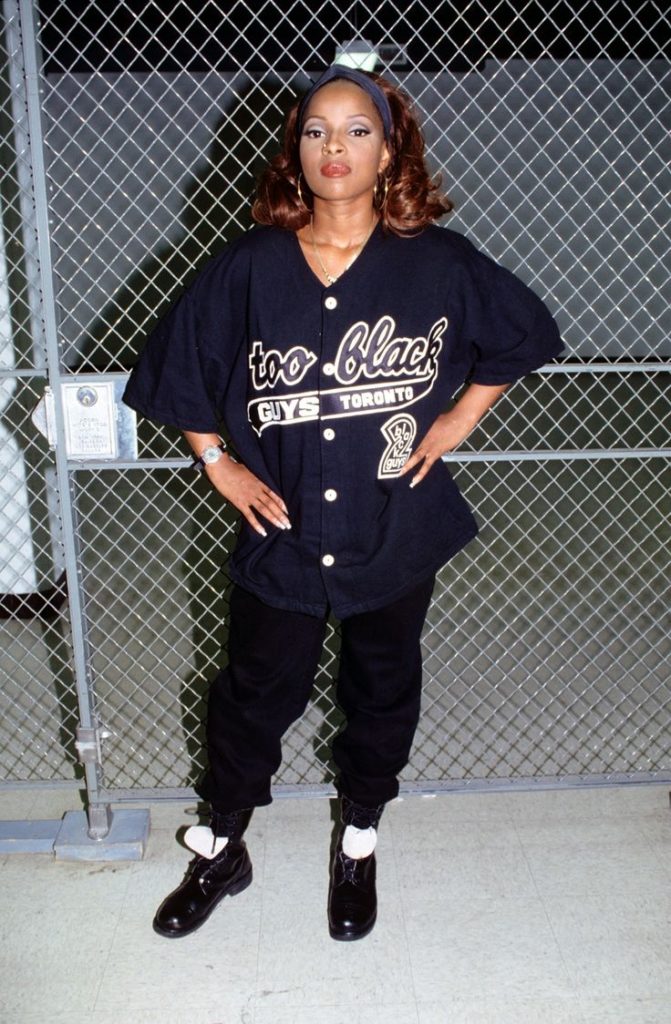
As 1992 began, the music industry was changing dramatically. The Nirvana-led alternative/grunge movement now included Seattle’s other musical heavyweight, Pearl Jam. Suburban youth who used to do the “running man” to BBD now rejected Pop/R&B music, questioning its integrity and flocking to what they considered “real music” – the sounds of neo-punk angst. That spelled doom for solidly crossover acts such as Paula Abdul, Color Me Badd, the C&C Music Factory, and especially, MC Hammer, who by that time had dropped the MC to reinvent himself.
A new crop of urban acts were emerging: 2Pac, Shanice, Mint Condition, TLC, Naughty By Nature, Cypress Hill, and R. Kelly just to name a few. The two most promising R&B groups during this time were Boyz II Men, and Jodeci. While Boyz II Men had arrived with a lot of fanfare during the summer of 1991, Jodeci seemed to creep in through a side door. Although their debut album Forever My Lady was also released in ‘91, it wasn’t until that fall that the LP’s title track put Jodeci in the spotlight. Jodeci would continue their singles winning streak with “Stay” and “Come And Talk To Me,” remixed by an up-and-coming producer/label exec by the name of Sean “Puffy” Combs…
At the movies, Kid’N’Play’s House Party 2 didn’t really live up to the original. However, another movie directed by Spike Lee’s former cinematographer Ernest Dickerson made a huge impact on urban moviegoers everywhere, and that film was Juice. Featuring unforgettable performances by Omar Epps and Tupac Shakur (whose debut album 2Pacalypse Now would be released two months later), the Juice film seemed to herald the start of the characteristically bleaker nature of post-New Jack Swing urban culture. The Juice soundtrack featured Big Daddy Kane’s last major hit “Know The Ledge,” Naughty By Nature’s “Uptown Anthem,” and Teddy Riley’s “Is It Good To You” featuring Tammy Lucas – one of the last (and best) New Jack hits of 1992.
Spurred primarily by a marked decline in ratings, it was decided that the Cosby Show would air for the last time on Thursday, April 30th, 1992. Meanwhile on April 29th, the four LAPD officers videotaped and accused of beating Black motorist Rodney King were acquitted by an all-White jury. In direct response to the acquittal, riots erupted across the city of Los Angeles, and continued to occur over the next several nights.
Then in a truly sad and ironic twist of fate, the planned April 30th broadcast of the Cosby Show’s final episode was tarnished by live news coverage of the Los Angeles riots for millions of West Coast viewers that Thursday night. When the Cosby Show ended (the 1980s most popular sitcom), it symbolized the end of an era in racial progress. The L.A. riots (and the direct cause of it) on the other hand, symbolized the birth of a new era hinted at by suburban America’s sudden backlash against Pop/R&B music: the re-solidification of racial divisions in the U.S.

As things slowly returned to normal after the riots, Atlanta-based “urban” music came to the forefront thanks to the production efforts of Jermaine Dupri, Dallas Austin, and LaFace records. The two biggest southern acts to emerge during this period were Kris Kross and TLC. Both of these acts took cues from BBD in that they incorporated a distinct look into their campaigns. With Kris Kross, it was wearing their clothes backwards, while with TLC it was bright, over-sized tomboy clothing. Both Kris Kross and TLC went on to enjoy phenomenal success in 1992 and 1993; and for TLC it was only just the beginning…
The summer of 1992 was a historic one for R&B – it was the first time that it would be celebrated largely without the support of suburban audiences since the late 1980s. Hammer’s World Tour featured opening acts TLC, Jodeci, and Boyz II Men; for concert goers lucky enough to have attended that show, they’d witnessed one of the best artist lineups urban music would ever witness that decade.
At the movies, Eddie Murphy returned with the hilariously classic Boomerang, directed by Reginald Hudlin (1990’s House Party), while Damon and Marlon Wayans emerged with Mo’ Money. Producers LA & Babyface produced the Boomerang soundtrack, while Jimmy Jam & Terry Lewis produced the soundtrack for Mo’ Money, resulting in what became the musical showdown of the summer. In the end however, it was fans of R&B who’d won out. With unforgettable classics such as: “I’d Die Without You” (PM Dawn), “The Best Things In Life Are Free” (Janet Jackson & Luther Vandross), “Love Shoulda Brought You Home” (Toni Braxton), and most notably, Boyz II Men’s “End of The Road,” the summer of 1992 was a magical one in Black music.
En Vogue’s remake of “Giving Him Something He Can Feel” received heavy rotation on MTV, just like their previous hit “Never Gonna Get It (My Lovin)” had in late ’91, making their sophomore LP Funky Divas their biggest album yet. Bobby Brown finally made his return with the Bobby album, featuring “Humpin Around” as the first single. R. Kelly was fast becoming a major force in R&B – his hits “She’s Got That Vibe,” “Honey Love,” and “Slow Dance” were all huge hits with urban audiences, and the best part about it for him was not only could he sing, but he was also a gifted producer.
By the fall of 1992, musical tastes between suburban and urban audiences had become hopelessly separated – in stark contrast to the way things were back in 1990. The sprawling success of country acts like Garth Brooks and Billy Ray Cyrus in addition to the thriving grunge movement drove an even deeper wedge into the musical divide. In response, a new form of R&B emerged, one that no longer had the crossover appeal that New Jack Swing did. That new form of R&B was called Hip-Hop/Soul, and it shared the same birthplace that New Jack Swing did – MCA’s Uptown Records.

At Uptown, it was Sean “Puffy” Combs who in large part molded the look and sound of Hip-Hop/Soul acts Jodeci and Mary J. Blige, who would come to define what post-New Jack Swing R&B was going to be all about. When Mary J. Blige arrived on the scene with “You Remind Me” and “Real Love,” it was official: this new style of R&B wasn’t being made to necessarily cross over – rather, this was urban music being made for urban audiences, period.
A flurry of Hip-Hop/Soul R&B groups emerged during the end of 1992, including Shai (“If I Ever Fall In Love”), SWV (“I’m So Into You”), Portrait (“Here We Go”), and returning for their second outing, Hi-Five (“She’s Playing Hard To Get”). The trend would continue on into 1993, the last year of the post New Jack Swing era – the year that the last vestiges of New Jack Swing would finally peter out.
On December 15th 1992, ex-NWA member Dr. Dre would finally release his solo debut, The Chronic, which struck a perfect balance between undeniable musical genius, and gun-toting, weed-smoking, vulgar social rebellion. The Chronic album presented the most demeaning caricatures of Black people that America had seen since minstrelsy; and suburban fans (in particular) ate it up, making room in their mainly rock/alternative CD collections for Gangsta Rap. The suburban audience’s embrace of Gangsta Rap would send Dr. Dre, Snoop Doggy Dogg, and the rest of the Death Row records brood soaring atop the charts over the next three years…
Editor’s Note: Perhaps it was the negative images of the L.A. riots that fueled America’s 1990s obsession with Gangsta Rap. Before the riots, some “Gangsta” Rap actually contained socially redeeming elements:
*Ice-T had several pro-social hits: the anti-drug song “I’m Your Pusher” (1989), the cautionary “High Rollers” (1989), and “You Played Yourself” (1990).
*N.W.A denounced drug use on “Dopeman” (1989), weed on “Express Yourself” (1989), and drunk-driving “Don’t Drink That Wine” (1991).
*The Stop The Violence Movement recorded “Self Destruction” (1989), and the West Coast Rap All Stars (featuring N.W.A., and others) got together to record “We’re All In The Same Gang” (1990).
*KRS-One’s “Criminal Minded” (1987) has been hailed by scholars as the first Gangsta Rap album, yet KRS-One (a.k.a. “The Teacher”) has always been recognized for his pro-social lyrics. One of his most popular New Jack Era “conscious” recordings is “Love’s Gonna Get Cha (Material Love)” (1990).
In short, the “Golden Age of Hip-Hop” was in actuality, the rap foundation of the New Jack Swing Era. When New Jack Swing ended, the “Conscious Hip-Hop” era diminished along with it.
1993

